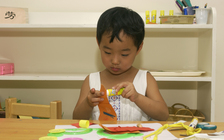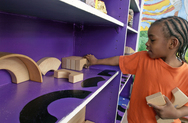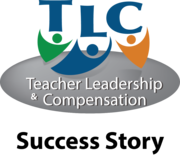|
June 14, 2019 Vol. 7
 Supporting Fine Arts educators
Fine
arts modules support standards implementation
Five professional
development modules supporting the implementation of Iowa’s new fine arts
standards are under development, according to Angela Matsuoka, fine arts
consultant at the Department of Education. Matsuoka expects that the modules
will be ready for educators’ use by the end of summer.
“Something
educators will be really excited about in these modules is the examples of how standards
are used in fellow-Iowa fine arts educators’ classrooms. We’ll be including
assessments, lesson plans, and unit plans from other teachers. These
applications should help educators with their practice and implementation of
the standards,” Matsuoka said.
The
modules include information of standards design and history, the structure of
the standards, a discipline specific look at the standards, unit design using
the standards, and assessment. The standards, which were adopted in 2017,
address these disciplines: dance, general music, instrumental music, media
arts, theatre, visual art, and vocal music.
Members of
the Statewide Fine Arts Leadership Team are working on the modules. The team
includes teachers, AEA consultants, and university and college faculty. Members
were chosen to have expertise in each of the disciplines included in the
standards.
The
modules will be self-paced learning courses accessible through AEA Learning
Online. Administrators, TLC leaders, or
teachers who complete all five modules will be eligible for one license renewal
credit.
For more
information, contact Angela Matsuoka at angela.matsuoka@iowa.gov or (515) 782-7296.
|
 Changing lives
After-school
programming improves at-risk children’s achievement, behavior, attendance
The 21st
Century Community Learning Centers (21 CCLC) programs in Iowa are contributing
to the lives of at-risk children by helping them improve attendance and
behavior, and make gains in reading and mathematics.
Data from
the U.S. Department of Education’s Annual Performance Report shows that in Iowa
66 percent of the students who participate in the program have improved in
reading and 75 percent have improved in mathematics. Afterschool attendance in
Iowa is also on the rise, increasing from 42 percent to 68 percent in 2017.
The number
of students served in afterschool programs funded by the 21 CCLC program has
increased, as has funding. In 2011, Iowa’s grant was $4,000,000 and 6,203
children were served in 51 sites statewide. In 2017, 14,679 children were
served in 103 sites and Iowa’s funding had grown to $6,825,000.
According
to Vic Jaras, program consultant at the Department, there’s a correlations
between afterschool programs and improved student behavior. “Without exception,
in every school that I visit and talk with the principal, he or she reports
that when an afterschool program starts in their building, attendance goes up
and referrals to the office for misbehavior go down dramatically.” Data from
the Sioux City and the Council Bluffs Police Departments indicates that both
cities have experienced dramatic reductions in juvenile arrests between the
hours of 2 and 5 p.m., which may at least in part be due to the successful
implementation of 21st CCLC programs, according to Jaras.
The Sioux City police report the percentage of juvenile arrests between the hours of 2 and 5 p.m. have consistently declined during the three years of grant implementation: down 24 percent in the first year, down 33 percent in the second, and down 37 percent the third.
The
Council Bluffs Police Department reported a 50 percent reduction in the number
of juvenile arrests between the hours of 2 and 5 p.m. – from 262 arrests in
2014 to 128 arrests in 2017.
One of the
reasons why we’ve had such success in Iowa, Jaras notes, is that Iowa has a
sense of community that other states don’t have. “Iowans really value their
schools and communities. A requirement of this program is schools and
communities working together. 21 CCLC programs tap into this
resource, requiring that the after-school program seek the support of business
and community resources.
For more
information, contact Vic Jaras, 21st Century Community Learning
Centers consultant, at vic.jaras@iowa.gov or (515) 402-2729.
|
 Recommended standards for K-12
Computer
Science standards to go to the State Board
A
statewide standards review team has met monthly from January to May and is
sending its recommendation for K-12 computer science standards to the State
Board on Friday, June 15.
The team
reviewed sets of computer science standards from other states and national
organizations and selected the K-12 Computer Science Standards from the
Computer Science Teacher Association (CSTA) as the set they would recommend. In
making their selection, the team reviewed feedback from an online public survey
and two public forums and found strong support among educators at all grade
levels, as well as parents and other community members to adopt the CSTA
standards. The team also recommended the creation of a guidance document to
assist educators in implementing the standards.
The
computer science standards are recommended
standards. This means that schools and districts have the option to implement
them for students. But those who served on the review team see computer science
education as essential.
“Iowa students deserve opportunities to learn and experience
computer science, which has become a basic skill,” said Ann Wiley,
instructional technology coordinator for the Johnston Community School District
and a member of the computer science standards review team. “We must raise
expectations for computer science knowledge and skills in Iowa schools so that
students are prepared for the demands of postsecondary education and the
workforce.”
To support
the implementation of the recommended standards legislature allocated
$500,000 for a computer science professional development incentive fund. The
intent of this fund is to increase the number of computer science teachers. The
districts that receive the computer science incentive funds will be able to use
it to train teachers to teach computer science, which includes implementing the
computer science standards, and tuition reimbursement for educators seeking
endorsements and certifications in computer science. The Department is
accepting applications for this fund mid-June. Look for it on iowagrants.gov.
For more
information, contact Erika Cook, Standards and Curriculum bureau chief, at erika.cook@iowa.gov or (515) 240-3103.
|
 Early Learning Standards revised
Depth
and breadth of standards broadened, increased emphasis on math and science
Iowa’s
Early Learning Standards have been revised to reflect current research and
alignment to the Iowa Academic Standards.
Through
the efforts of Early Childhood Iowa, a collaboration among the Department of
Education, Department of Human Services, and other entities, the standards have
been reshaped “to recognize that not everyone is going to come at this subject
as a teacher or administrator,” according to Kimberly Villotti, administrative
consultant with the Bureau of Standards and Curriculum at the Iowa Department
of Education. “Moving away from educational jargon means the vocabulary is more
relevant to a parent or caregiver who is always observing what a child can and
cannot do and bouncing it against what typical development would look like,”
she said.
Based
on both research and theory in child development and early education, Iowa’s
Early Learning Standards are intended as a resource to help support and enhance
children’s learning and development, and a tool to share information among
families, caregivers, and child care professionals. The goal is to help every
child, beginning at birth, be healthy and successful (Early Childhood Iowa’s
Vision).
“In
early childhood we talk about the whole child,” Villotti said. “We created
alignments of English language arts and mathematics, and now we have upped the
ante by adding social studies, science, and fine arts. It’s not a checklist for
entry to school or as a foundation of expectation, but rather a tool to help
teachers and caregivers recognize what young kids focus on. It’s a symbiotic,
reciprocal relationship. Both teachers and care givers have skin in the game
with these kiddos. The document helps validate and affirm to care givers that
they are doing instruction, and providing opportunities in fine motor, in
language, in science, in social emotional supports. It’s a common understanding
and language so we can best support kids.”
Initially,
math and science standards were grouped together. That has changed because of
new knowledge about the value of inquiry and importance of engineering concepts
gained through science, technology, engineering, and math (STEM) education. A
stronger, more intentional emphasis on opportunities for both math and science
experiential exploration is achieved by having math and science broken out and
acknowledged separately.
“People tend to shy
away from mathematics in early childhood contexts,” Villotti said. “Mathematics
can be daunting to most people. We know that many people hear the word
mathematics and get quite anxious. We took math concepts that are abstract,
theoretical, and conceptual and put them as concretes.
“We decided what
mathematical practices look like for an infant or toddler, then described what
an adult can do in a very simplistic way with a very young child to reinforce
the math concepts. I can read about, mimic, and replicate the action steps with
young kids and know that’s my contribution. I can help kids approach a
mathematical situation and not feel overwhelmed, as well as reduce my own
anxiety. We wanted to be intentional about making math approachable and
understandable.”
For more information,
contact Kimberly Villotti, administrative consultant for Early Childhood
Education, at Kimberly.villotti@iowa.gov
or (515)201-5067.
|
Data can
support teacher leaders in fostering change
Although
teachers have access to a great deal of data, they do not often use that data
to drive classroom instruction. Teacher leaders may have the responsibility of being a data coach
to support teachers in analyzing, interpreting and using a variety of data to
improve decision making at the classroom and school level. Data may include student work samples,
classroom observations, formative assessments and standardized test results.
Teacher
leaders may help teachers interpret data, but most importantly they help
teachers to use data to make informed decisions about student learning. Teacher leaders can help individuals, teams,
and administrators discover how to best use data. In order to facilitate these types of data-based
conversations, teacher leaders need to establish an environment that allows
teachers to feel safe. A critical part
of any data-based conversation is being able to identify an action based on the
data.
Leaders
can help to focus on the area that may make the greatest impact for the
action. These areas could include
instruction, formative assessment, lesson planning, instructional resources,
and professional learning. Teacher leaders who coach around data are
instrumental school improvement. Teacher
leaders may spend a large amount of time in the area of data based decision
making.
Killion,
J., & Harrison, C. (2017). Taking the
lead: new roles for teachers and school-based coaches. Second Edition. National Staff
Development Council: Oxford. OH.
For more
information, contact Lora Rasey, Teacher Leadership and Compensation
consultant, at lora.rasey@iowa.gov or
(515) 419-2088.
 Asking the right questions
Data
drives changes in Indianola’s TLC program
Leaders of
Indianola Community School District’s Teacher Leadership and Compensation (TLC)
program have been focused on using data to improve the implementation of their
program since the district was first funded three years ago. But this year they
are sharpening their focus to examine the data that will help them assess the
impact of instructional coaching on student achievement.
“We’ve
been looking at the same sources of data that other districts have – the Iowa
Assessments and FAST assessments – but now we want to get a bit more specific
about the impact that coaching is having on instruction and student learning,”
Kevin Schlomer, district TLC coordinator, said. “Can we identify some places
where students have made growth and can that growth be connected back to the
coaches’ work? This is the question we want to focus on.”
Funded
through TLC are 11 full-time positions – instructional coaches and program
development coaches. While the instructional coaches focus on supporting
improved instruction, the program development coaches are working with teachers
in the areas of standards and assessments and the Iowa Academic Standards. In
addition to the full-time positions, TLC also funds release time for 23
Collaboration and Innovation (C and I) teachers and 27 members of the district
leadership team.
Kim
Grissom, who will replace Schlomer as TLC coordinator July 1, said she will be
looking specifically at the C and I teachers because “that is where TLC meets
the classroom. Those teachers work closely with coaches who support their professional
learning. We hope to gather some data on the C and I teachers and we’ll be
looking for change over time,” she said.
One
example of how this district uses data to assess the TLC program is a study
they conducted on the amount of instructional coaches’ time that is devoted to
working with teachers in a coaching cycle. The recommended amount of time was
60-70 percent, but they found that due to competing instructional management
duties (working with teachers on FAST assessment implementation and
interventions), elementary coaches were actually spending less than 10 percent
of their time coaching teachers through improvement cycles. Although leadership
agreed that these instructional management tasks were important, they were
taking a lot of time.
As a
result of their study, the district will add an elementary at-risk coordinator
to work with student interventions, MTSS, and the FAST assessments in reading
and mathematics. This position will begin in the fall of 2018. Their hope is
that this will free up instructional coaches to focus on working with teachers
in improving instruction through coaching cycles.
|
|